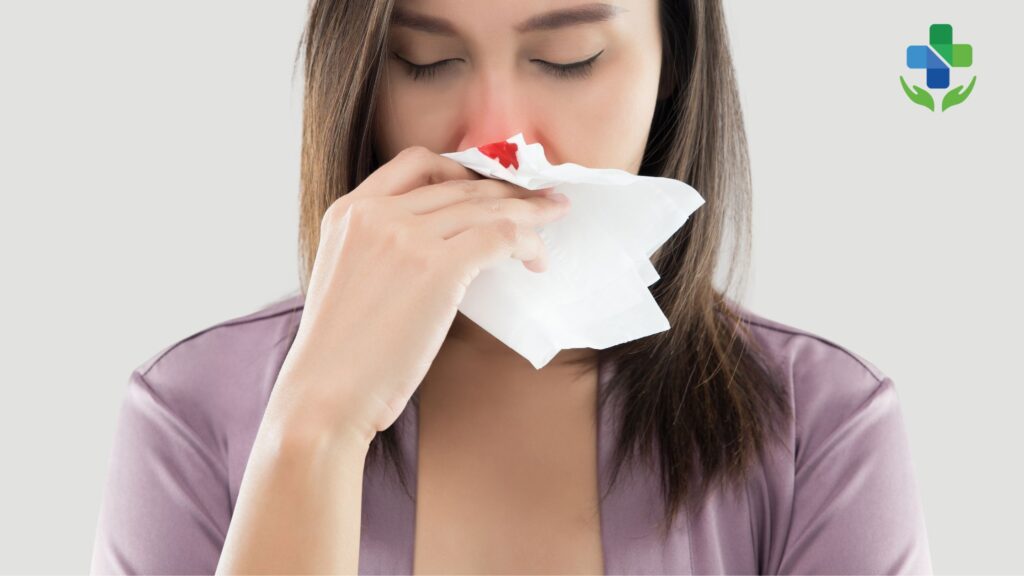In this article, let’s explore the causes of nosebleeds during summer and provide practical tips for managing nosebleeds in summer.

Managing Nosebleeds in Summer – Table of Content
- 1. Introduction
- 2. Understanding Nosebleeds: An Overview
- 3. Understanding the Summer Factors That Trigger Nosebleeds
- 4. Other Causes of Nosebleeds
- 5. Managing an active nosebleed: Treatment Options
- 6. Managing the Nosebleed: Treatment Options
- 7. When to Seek Medical Attention
- 8. Tips for Preventing and Managing Nosebleeds in Summer
- 9. The Bottom Line
Introduction
Nosebleeds, also known as epistaxis, can be an alarming and uncomfortable experience and occur more frequently during the summer months due to various factors. The combination of dry hot air, increased outdoor activities, and potential dehydration can make the delicate blood vessels in the nose more susceptible to bleeding. Whether they occur spontaneously or as a result of trauma, nosebleeds can be a cause for concern.
Understanding Nosebleeds: An Overview
Our nose has to perform a function of conditioning air within a fraction of a second, to ensure humidified filtered, and conditioned air reaches our lungs. To perform this there is ample blood supply inside the nose. Nosebleeds occur when the delicate blood vessels inside the nose rupture and bleed. Doctors categorized epistaxis into two types: anterior nosebleeds and posterior nosebleeds. Anterior nosebleeds are the most common and originate from the blood vessels in the front of the nose. Posterior nosebleeds are relatively rare and originate from the blood vessels deeper within the nasal cavity.
Understanding the Summer Factors That Trigger Nosebleeds
During the summer, several factors contribute to the increased occurrence of nosebleeds:
1. Dry and Hot Weather
The summer season often brings dry and hot weather conditions, which can lead to reduced humidity levels. Low humidity can cause the nasal passages to become dry, making the blood vessels more fragile and prone to bleeding. Nasal irritation caused by allergies, colds, or sinus infections can also contribute to nosebleeds.
2. Dehydration
Hot temperatures and increased physical activity in the summer can result in dehydration. When the body lacks proper hydration, the nasal membranes can dry out, increasing the risk of nosebleeds.
3. Allergies and Irritants
Summer allergies, such as hay fever, can cause nasal congestion and inflammation. Additionally, exposure to irritants like pollen, dust, and air pollution can further irritate the nasal passages, making them more susceptible to nosebleeds.
Other Causes of Nosebleeds
- Accidental trauma, such as a blow to the nose, can cause blood vessels to rupture, resulting in a nosebleed. Nose picking, vigorous nose blowing, or inserting foreign objects into the nostrils can also lead to bleeding.
- Nasal Conditions and Medical Disorders-Certain medical conditions, such as high blood pressure, bleeding disorders, liver disease, or nasal structural abnormalities like a deviated septum, can increase the risk of nosebleeds. Regular use of certain medications, like blood thinners, may also contribute to their occurrence.
Managing an active nosebleed: Treatment Options
When faced with a nosebleed, it is essential to remain calm and take the appropriate steps to stop the bleeding. Here are some effective measures to manage nosebleeds:
Applying Pressure and Leaning Forward
Pinching the soft part of the nose, just below the nasal bone for up to 10-30 minutes, and leaning slightly forward can help slow the bleeding. Sit on a high surface, so that your legs will be hanging down. This action helps pool your blood to your lower body, prevents blood from flowing down the throat, and reduces the risk of swallowing blood. You can also apply ice or ice packs over the bridge of the nose or forehead for some time.
People with hypertension can consider watching for their blood pressure and if required can consult a physician for high BP.
Please note the above-mentioned method is to temporarily hold the bleeding till you are able to take proper consultation. For any kind of nose bleed it is better to show it to an EAR, NOSE, and THROAT specialist.
Managing the Nosebleed: Treatment Options
1.Nasal Moisturization
Using saline nasal sprays or applying a thin layer of petroleum jelly inside the nostrils can help keep the nasal passages moisturized. This minimizes the risk of dryness and subsequent bleeding.
2.Nasal Packing and Cauterization
In severe cases, where nosebleeds are difficult to control, healthcare professionals may resort to nasal packing or cauterization. Nasal packing involves placing a gauze or balloon-like device in the nose to apply pressure and stop the bleeding. Cauterization involves using heat, silver nitrate, or electrical current to seal the bleeding blood vessels.
When to Seek Medical Attention
- In most cases, nosebleeds can be managed at home using the aforementioned tips. However, it’s important to know when to seek medical attention.
- If the nosebleed lasts for more than 20 minutes despite applying pressure.
- If the bleeding is severe and difficult to control.
- If nosebleeds become frequent and recurrent.
- If nosebleeds are accompanied by other concerning symptoms.
Tips for Preventing and Managing Nosebleeds in Summer
Adopting certain habits and making lifestyle changes can help reduce the occurrence of nosebleeds. Consider the following preventive measures:
1.Hydrate Yourself
Staying properly hydrated is crucial in preventing nosebleeds during the summer. Drink an adequate amount of water throughout the day to keep your body well-hydrated and maintain moisture in the nasal passages.
2.Use a Humidifier
To counteract the dry air, especially in summers and indoors where air conditioning may be in use, consider using a humidifier. A humidifier adds moisture to the air, helping to prevent nasal dryness and reduce the risk of nosebleeds.
3.Nasal Saline Sprays
Regularly using nasal saline sprays can help keep the nasal passages moist and prevent them from drying out. Saline sprays also help clear any irritants or allergens that may contribute to nosebleeds.
4.Protect Your Nose from Sunburn
Excessive sun exposure can lead to sunburn, including on the nose. Sunburnt skin can become dry and more prone to nosebleeds. Apply sunscreen with a high SPF to protect your nose and other exposed areas from harmful UV rays.
5.Avoid Nose-picking and Irritation
Refrain from picking your nose or inserting any objects into your nostrils, as this can irritate the delicate blood vessels and potentially cause nosebleeds. Keep the nasal passages clean by gently blowing your nose using soft tissue.
6.Use Nasal Moisturizing Products
Consider using nasal moisturizing products, such as petroleum jelly or nasal gels, to keep the nasal passages hydrated and prevent dryness. Apply a thin layer inside the nostrils as needed, especially before going outdoors.
7.Manage Allergies
If you suffer from summer allergies, consult with a healthcare professional for appropriate medications or allergy management strategies. Addressing allergies can help reduce nasal inflammation and minimize the risk of nosebleeds.
8.Avoid Nasal Irritants
Stay away from irritants like cigarette smoke, strong chemical fumes, and allergens, as they can cause nasal irritation and trigger nosebleeds.
9.Gentle Nasal Care
Practice gentle nasal care by avoiding forceful nose blowing and refraining from picking your nose. Instead, use a soft tissue or a nasal saline spray to clear the nasal passages.
The Bottom Line
While managing nosebleeds in summer can be bothersome, implementing preventive measures and following the tips mentioned above can help you effectively manage and reduce their occurrence. Stay hydrated, maintain a moist nasal environment, protect your nose from sunburn, and be mindful of nasal irritants. Remember, if nosebleeds persist or become a cause for concern, it is advisable to seek medical advice for proper evaluation and guidance. Enjoy the summer season with confidence and a nosebleed-free experience!
